The Old Kingdom of Egypt and the Striking Evolution of Pyramids
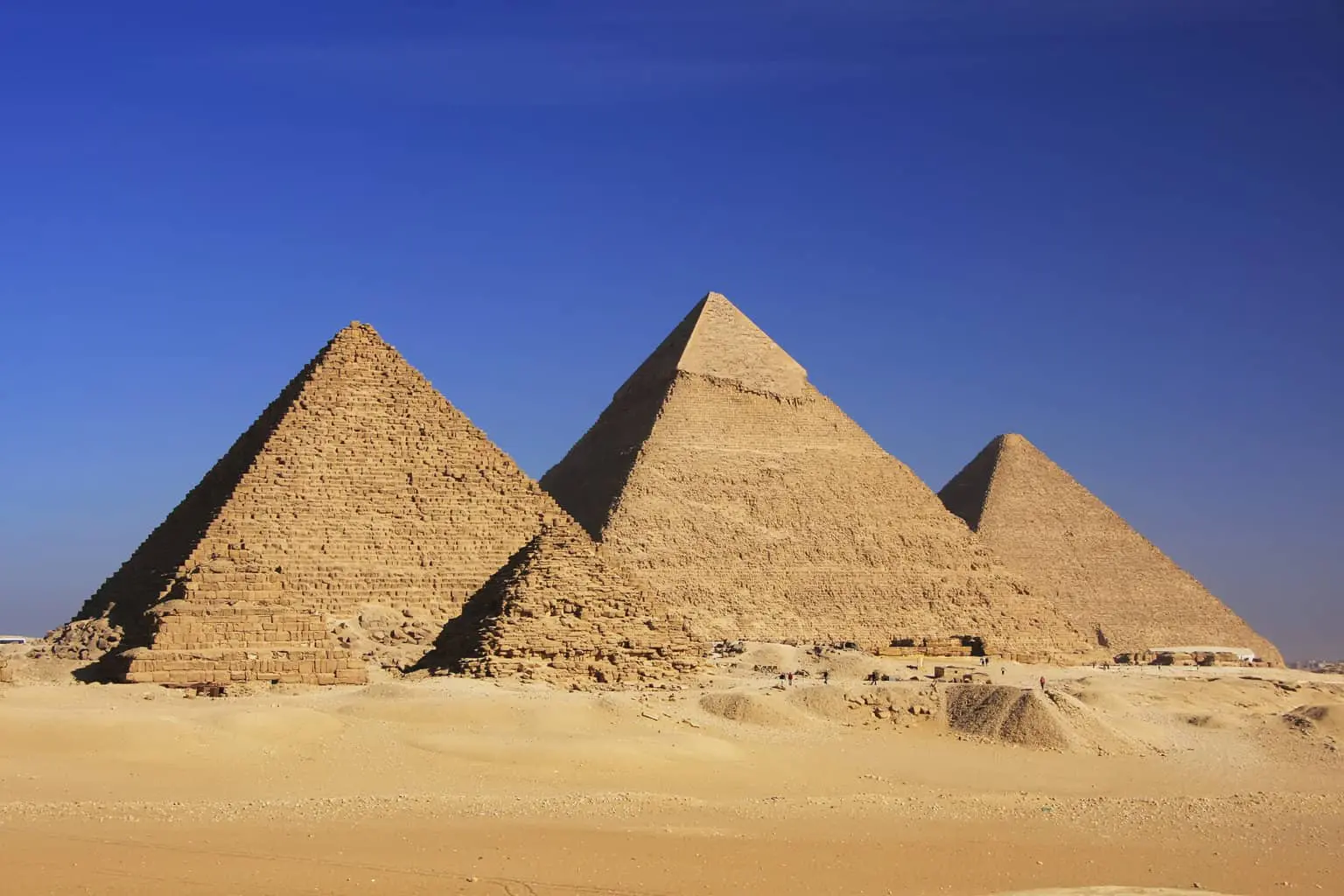
Updated On: February 19, 2024 by Noha Basiouny
The Great Pyramids of Giza are three mesmerising wonders one cannot get enough of. Just seeing them up close and realising they are as colossal as we are to a tiny four-week-old kitten ignites feelings of tremendous awe and astounding overwhelm. For thousands of years, they have stood as a gigantic representation of the excellence, cleverness and advanced engineering and technology ancient Egyptians attained back then.
Constructing the Pyramids, however, comes as no surprise when considering the time and context they were built in. They, in fact, saw the light during the first of the three golden ages of ancient Egypt, a period known as the Old Kingdom. These golden ages were the climax of the entire Egyptian civilisation, during which the country witnessed an enormous peak in innovation, architecture, science, art, politics and internal stability.
In this article, in particular, we will look into the Old Kingdom of Egypt and the architectural evolution that eventually led to the construction of the world’s most well-known necropolis. So bring yourself a cup of coffee and let’s hop into it.
The Old Kingdom of Egypt
So basically, ancient Egyptian civilisation stretched over almost 3,000 years of native Egyptian rule, with the beginning marked by the year 3150 BC and the end happening around 340 BC.
To better study this long-lasted civilisation, Egyptologists divided it into eight main periods, during each of which Egypt was ruled by several dynasties. Every dynasty comprised several kings, and sometimes queens too, who left an immense legacy so their descendants could remember them and, therefore, they would live for eternity.
The Old Kingdom was the second period, succeeding the Early Dynastic Period. It lasted 505 years, from 2686 BC to 2181 BC, and featured four dynasties. The Old Kingdom is pretty much the longest compared to the other two golden ages.
What is interesting about this period is that the capital city, Memphis, was in Lower Egypt, the northern part of the country. In the Early Dynastic Period, the capital, which the first Pharaoh, Narmer, built, was located somewhere in the centre of the country. In the Middle and New Kingdoms, it moved to Upper Egypt.
The Third to Sixth Dynasties
The Third Dynasty marked the beginning of the Old Kingdom. Established by King Djoser in 2686 BC, it lasted 73 years and featured four other pharaohs who succeeded Djoser before it ended in 2613 BC.
Then the Fourth Dynasty started. As we will see in a bit, it was the peak of the Old Kingdom, stretching for 119 years from 2613 to 2494 BC and featuring eight kings. The Fifth Dynasty lasted another 150 years, from 2494 to 2344 BC and had nine kings. Most of those kings had short reigns, ranging from a few months to 13 years at the maximum.
The Six Dynasty, the longest of all, continued for 163 years from 2344 to 2181 BC. Unlike its predecessor, this dynasty had seven pharaohs, most of whom had exceptionally long reigns. The longest, for instance, was that of King Pepi II, who is thought to have ruled for 94 years!
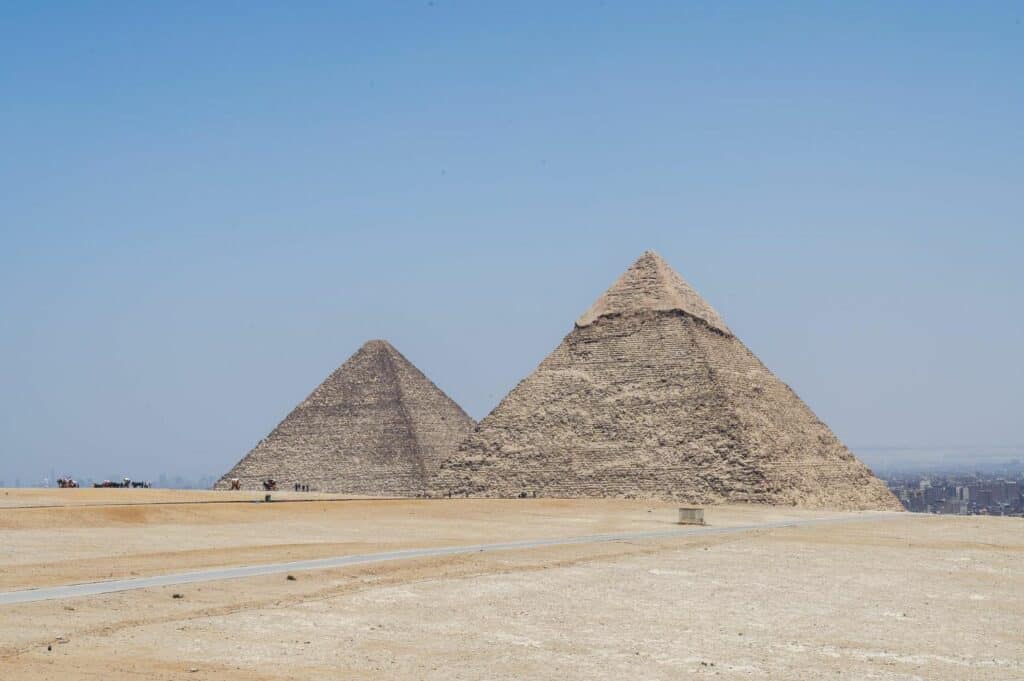
As we mentioned earlier, the Old Kingdom of Egypt is known as the era of building the Pyramids, and those are not just limited to the great three in Giza, by the way. Believe it or not, pyramid building was a trend during that period, and almost every pharaoh built himself at least one.
This very fact indicates how prosperous Egypt was at the time. Building such colossal monuments, which continued for half a millennium, required a massive, non-stop supply of financial and human resources. It also needed internal stability and peace with other nations, for if the country were dealing with conflicts, it would not have the ability to have such an extraordinary architectural development.
The Evolution of Pyramids
Interestingly, the engineering and technology that built the Great Pyramids of Giza did not just pop up overnight, but it was a gradual development that started even before the Egyptian civilisation itself started!
Understanding this is tied to the fact that ancient Egyptians built such enormous monuments to bury their royal deceased. The pyramids were, yes, tombs, except they were super colossal lavish tombs intended to survive forever.
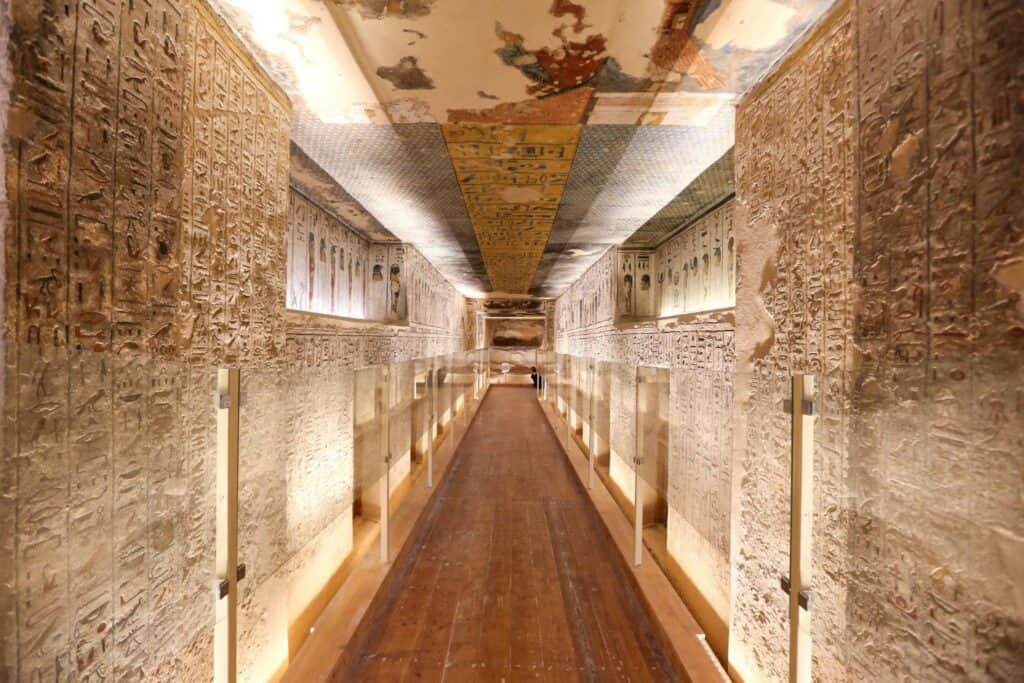
Ancient Egyptians believed in life after death and did everything to make sure the deceased would have a good stay in the next world. So they preserved the bodies of the dead and filled their tombs with whatever they thought would be needed over there.
In prehistoric times, way before 3150 BC, ancient Egyptians buried their dead in pretty ordinary graves, mere holes dug in the ground in which the bodies were placed.
But those graves were prone to deterioration, erosion, thieves and animals. If preserving the corpses was the aim, ancient Egyptians had to build more protective graves, which they did, and we eventually got the Great Pyramids of Giza.
So let’s look more into this magnificent evolution.
Mastabas
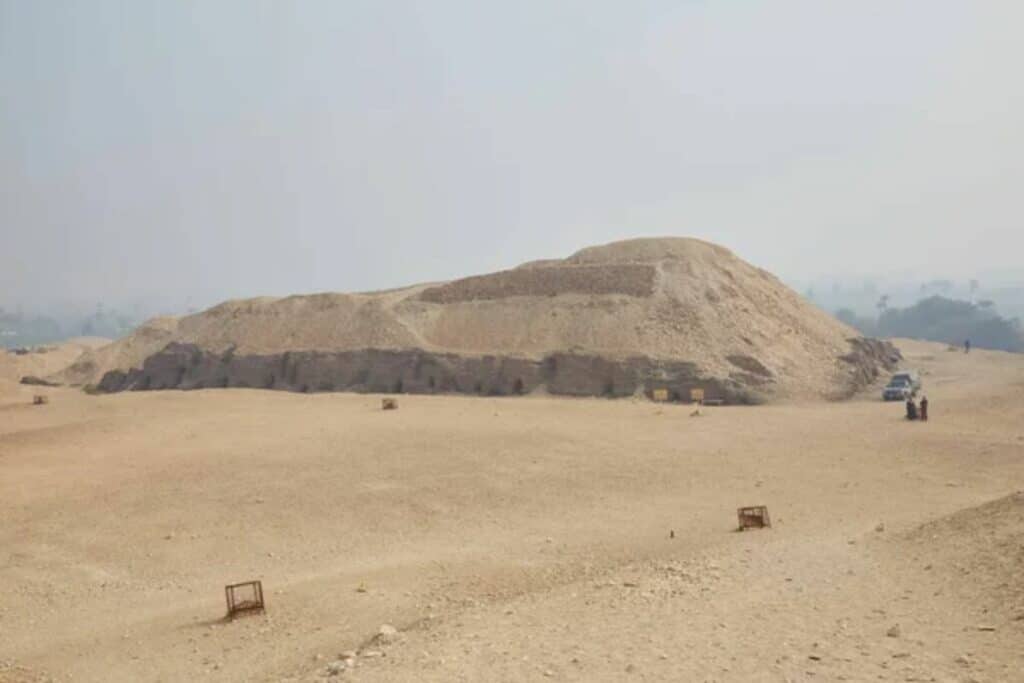
As the graves were not protective enough, ancient Egyptians developed mastabas. Mastaba is an Arabic word that means a mud bench. Still, ancient Egyptians called it something in hieroglyphs that meant the house of eternity.
Mastabas were rectangular-shaped benches made from sun-dried mud bricks which were in turn made from the nearby Nile Valley soil. They were about nine metres tall and had sides sloping inward. A mastaba was then placed above the ground, like a gigantic tombstone, while the tomb itself was dug deeper into the ground.
Interestingly, the construction of mastabas led to the invention of artificial mummification. The thing is, the early graves were closer to the surface of the ground, so the dry desert sand helped preserve the bodies of the dead. But when the bodies were moved deeper, they became more vulnerable to desecration. If they wanted to bury their dead under mastabas, ancient Egyptians had to invent mummification to preserve their corpses.
The Step Pyramid
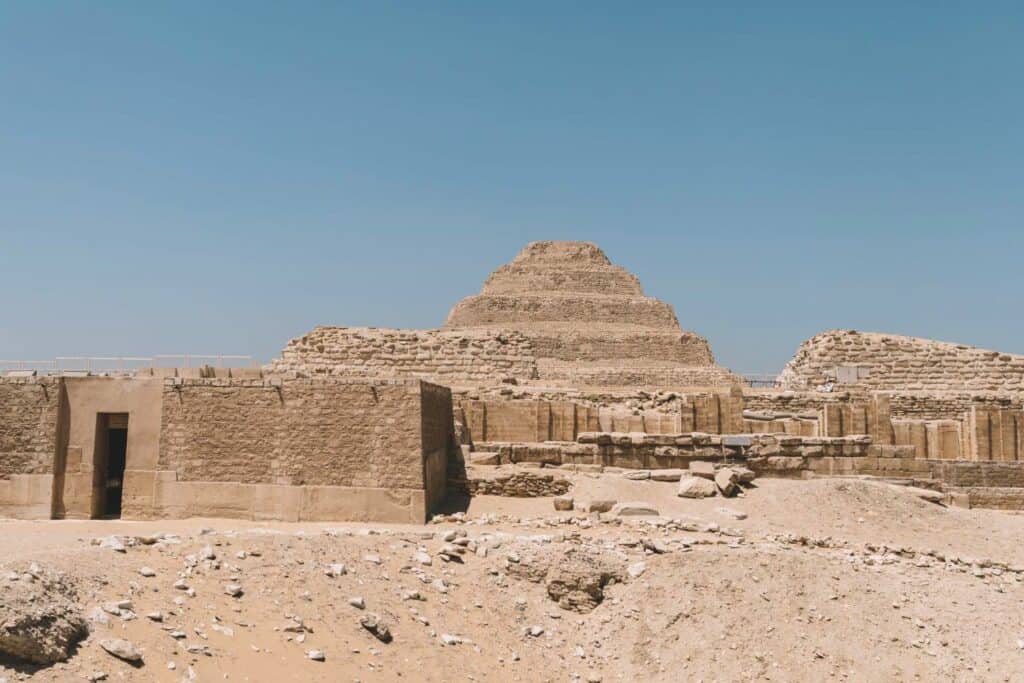
Then it was time to take mastabas to the next level.
Imhotep was the chancellor of King Djoser, the founder and the first pharaoh of the Third Dynasty. Like all the other pharaohs in Egyptian history, Djoser wanted a tomb but not just any tomb. So he appointed Imhotep to this noble job.
Imhotep then came up with the Step Pyramid design. After digging the burial chamber into the ground and connecting it with the surface through a passageway, he topped it with a rectangular flat limestone roof, which made the base of the construction and its very first and largest step. Then five more steps were added, each smaller than the one beneath it.
The Step Pyramid came out with a height of 62.5 metres and a base of 109 by 121 metres. It was built in Saqqara, a small town not very far from Memphis and what would later become a vast necropolis and a very sacred place for ancient Egyptians.
The Buried Pyramid
Sekhemkhet was the second pharaoh of the Third Dynasty. He reportedly ruled for six or seven years, which is relatively short, compared to his predecessors’ and successors’ reigns. Sekhemkhet, too, wanted to build his very own step tomb. He even intended to have it surpass that of Djoser.
Yet, it seemed like the odds were not in the new pharaoh’s favour for his pyramid, unfortunately, was never finished for some unknown reason.
While it was planned to be 70 metres tall with around six or seven steps, Sekhemkhet’s pyramid barely reached eight metres and had only one step. The unfinished building was prone to deterioration through the ages and remained undiscovered until 1951 when Egyptian Egyptologist Zakaria Goniem came across it while on an excavation in Saqqara.
With a height of only 2.4 metres, the entire construction was half buried under the sand, which earned it the nickname the Buried Pyramid.
The Layer Pyramid
King Khaba, or Teti, who succeeded Sekhemkhet, is believed to have built the Layer Pyramid. Unlike the previous two, this one was not built in Saqqara but in another necropolis called Zawyet al-Eryan, about eight kilometres south of Giza.
The Layer Pyramid was also supposed to be a step pyramid. It had a base of 84 metres and was planned to have five steps, altogether should have reached a height of 45 metres.
Although this monument may have already been finished in antiquity, it is currently ruined. What we now have is just a two-step, 17-metre-tall construction that looks so much like the Buried Pyramid. Yet, it does have a burial chamber some 26 metres under its base.
The Meidum Pyramid
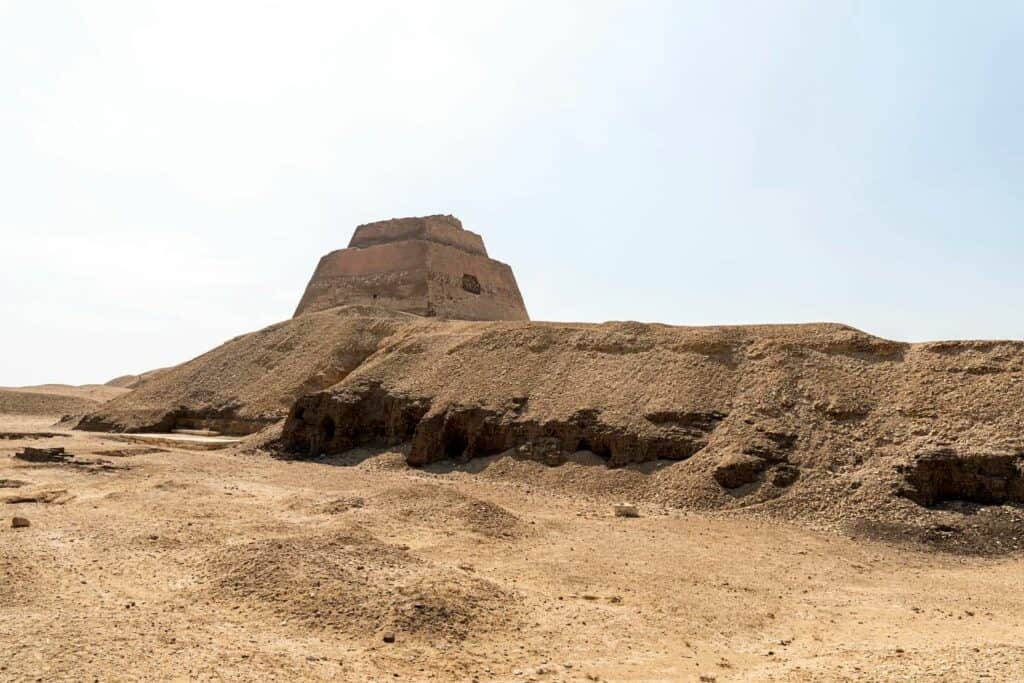
So far, there does not seem to be any development regarding building the pyramids. As we have seen, the two that succeeded that of Djoser were more of a failure. However, that was meant to change as some progress waved on the horizon with the construction of the Meidum Pyramid.
This Meidum, not Medium, Pyramid was built by Pharaoh Huni, the last ruler of the Third Dynasty. It somehow made the transition from the step pyramids to the true pyramids— those are the ones with straight sides.
You may think of this pyramid as having two parts. The first one is a huge 144-metre base made of several mud-brick mastabas that look like a small hill. On top of that, a few other steps were added. Every step is so thick, incredibly steep and just a little larger than the one above it. This still made it a step pyramid but with those almost straight sides, it looked more like a true one.
That said, it is believed that King Huni originally started this as a regular step pyramid, but when King Sneferu came to power in 2613 BC by establishing the Fourth Dynasty, he ordered its turning into a true one by filling the spaces between its steps with limestone.
The Bent Pyramid
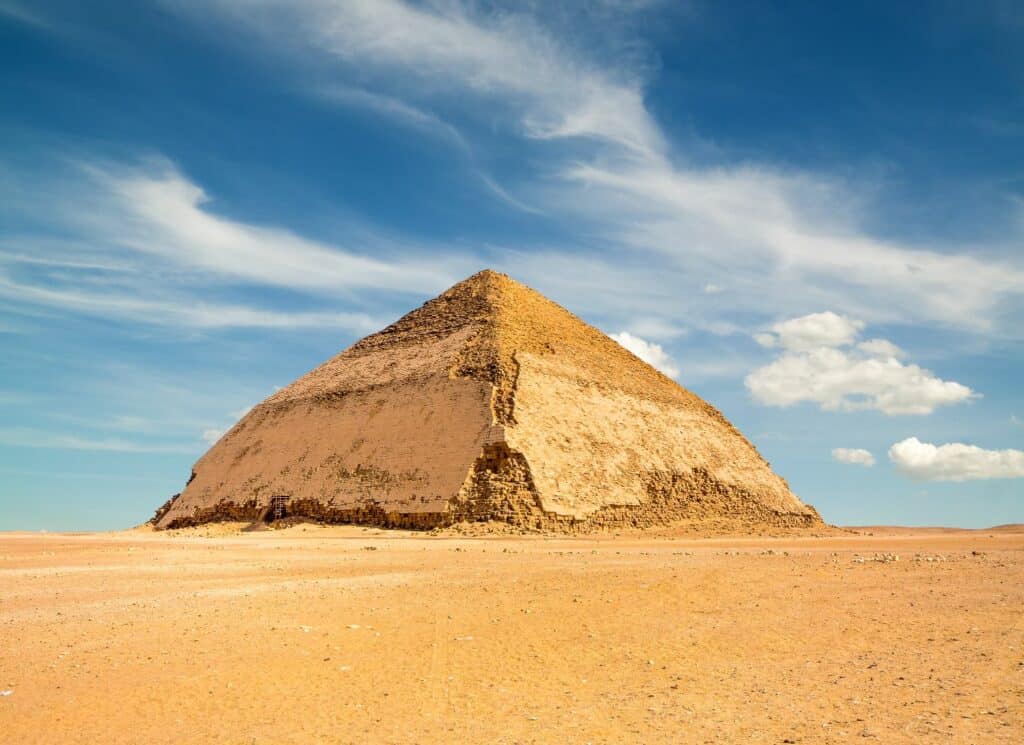
Being the son of Huni could be why Sneferu decided to convert his father’s tomb monument into a true pyramid. Apparently, he himself was fascinated by this perfect structure and insisted on turning it into a reality.
Sneferu was so persistent that he actually built two pyramids apart from the one he reconstructed.
The first of the two is a genuine attempt to create a true pyramid, a higher level than the Meidum Pyramid reached. Obviously, this construction was much larger than the previous ones, with a base of 189.43 metres and a height of 104.71 metres up into the sky.
An engineering error, however, made this pyramid have two sections instead of being one bulky structure. The first section, which starts from the base and is 47 metres tall, has a slope angle of 54°. Apparently, this was very steep and would have caused the building to grow unstable.
So the angle had to be reduced to 43° so as to prevent collapse. Eventually, the second section from the 47th metre up to the very top became more bent. Therefore, the structure was given the name the Bent Pyramid.
The Red Pyramid
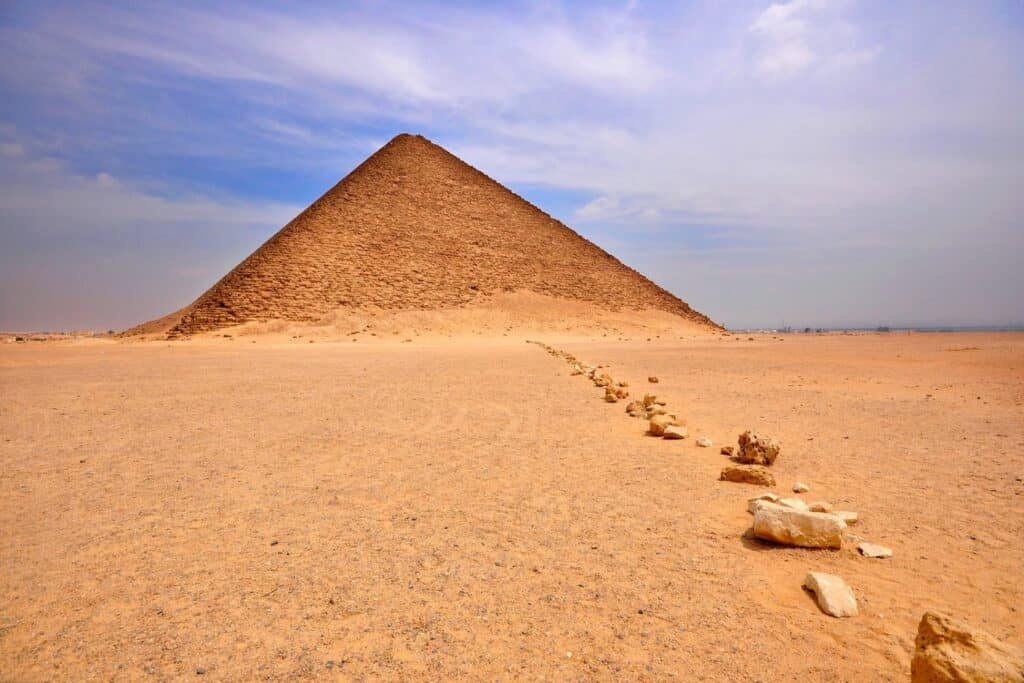
Sneferu was not discouraged by the not-so-true Bent Pyramid he built, so he decided to try with another one while keeping both the mistakes and corrections in mind. This did pay off, as his second attempt turned out just perfect.
The Red Pyramid, which was called so because of the red limestone it was made of, represents a sound development in engineering. The height was made 150 metres, the base stretched to 220 metres, and the slope was bent at 43.2°. Those accurate dimensions eventually led to a perfectly true pyramid, the world’s officially very first one.
The Great Pyramid of Giza
Now that ancient Egyptians had developed the proper engineering needed to build a true pyramid with a square base and four triangular sides, it was time to take things to a much higher level of excellence and perpetually astonish the world.
Khufu was Sneferu’s son. Once he became king in 2589 BC, he decided to build a pyramid that would surpass any other that was built before or would be built after.
Lucky for us, Khufu was a man of his word, and the Great Pyramid of Giza turned out to be a true embodiment of greatness and superiority, and there are many things that make it so.
First of all, Khufu’s pyramid is the largest in Egypt and the entire world. It has a base of 230.33 metres, almost a perfect square with just an average length error of 58 millimetres! The sides are triangular, and the inclination is 51.5°.
The height of the pyramid is actually a big deal. It was initially 147 metres, but after thousands of years of erosion and casing stone robbery, it now stands for 138.5 metres, which is still pretty tall too. In fact, the Great Pyramid remained the tallest building in the world until France’s Eiffel Tower, 300 metres, was built in 1889.
Secondly, it was made of 2.1 million large limestone blocks, collectively weighing about 4.5 million tonnes. They were large on the lower levels; each was more or less 1.5 metres tall but grew smaller toward the top. The smallest ones at the summit measured 50 centimetres.
The blocks on the outside were bound with 500,000 tonnes of mortar, and the ceiling of the King’s chamber was made of 80 tonnes of granite. The entire pyramid was then cased with smooth white limestone that dazzled under the sunlight.
Thirdly, each of the pyramid’s four sides is almost perfectly aligned with the cardinal directions, north, east, south, and west, with a deviation of only 10th of a degree! In other words, the Great Pyramid is the largest compass on Earth!
Wait! The accuracy party did not stop here. In fact, the entrance passage of the Great Pyramid is aligned with the North Star, while the circumference divided by the height equals 3.14!
The Pyramid of Khafre

Khafra was the son of Khufu but not his immediate successor. He came to power in 2558 BC as the fourth pharaoh in the Fourth Dynasty, and soon after, he proceeded to build his own large-scale tomb, which turned out to be the second-largest pyramid after that of his father.
The Pyramid of Khafre was also made of limestone and granite. It had a square base of 215.25 metres and an original height of 143.5, but it is now 136.4 metres. It is steeper than its predecessor, for its slope angle is 53.13°. Interestingly, it was built on a 10-metre gigantic solid rock, which makes it look taller than the Great Pyramid.
The Pyramid of Menkaure

The third of the three architectural masterpieces was built by King Menkaure. He was Khafre’s son and the grandson of Khufu, and he ruled for about 18 to 22 years.
The Pyramid of Menkaure was much smaller than the other two gigantic ones, further away from them but still as true as they were. It was originally 65 metres tall and had a base of 102.2 by 104.6 metres. Its slope angle is 51.2°, and it was also made of limestone and granite.
The construction of pyramids continued after the death of Menkaure, but unfortunately, none of the new ones was anywhere near the great three in terms of size, accuracy, or even survival. In other words, the Great Pyramids of Giza highlighted the pre-eminence of Egyptian engineering during the Old Kingdom.
Interested in more Egyptian history? if so, check out The Ankh – Symbol of life.






